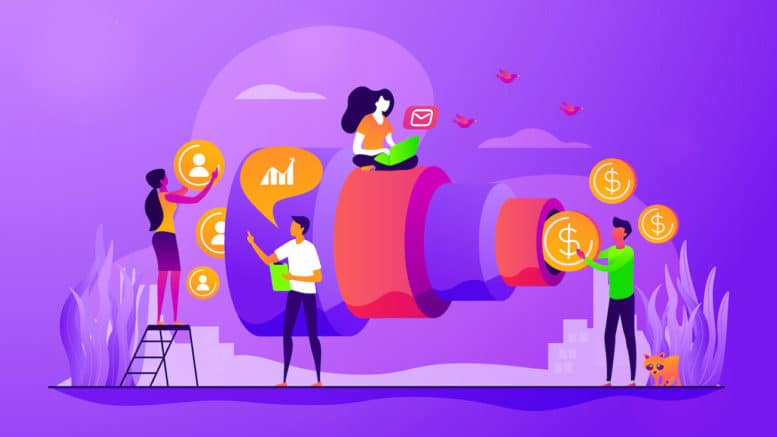There are many schools of thought when it comes to the customer value journey.
For some it’s 4 steps, others there are more than 8 steps and many have convoluted descriptions of what the stages of a customer journey through your sales funnel should be.
At Excalibur Press we work on the principle of 8 stages of the customer journey. In a nutshell these 8 stages are different psychological states that your prospect or buyer will move through before, during and after a purchase.
In some cases you will be able to easily identify these stages, especially when you have big ticket items and the customer journey is one that takes time and consideration. For smaller purchases it will be harder to define them and more difficult to target the customer at separate stages of the journey – this is why some schools of thought will decrease the stages and often merge some together.
Regardless of how long these stages are and the time spent by a prospect in them it is absolutely vital that you target your content creation, social posting, marketing and other sales activities to the right prospect at the right point in the customer journey.
34% of companies are implementing “customer journey mapping” into their customer service. Source: customerthermometer.com
This is what our 8 stages looks like:
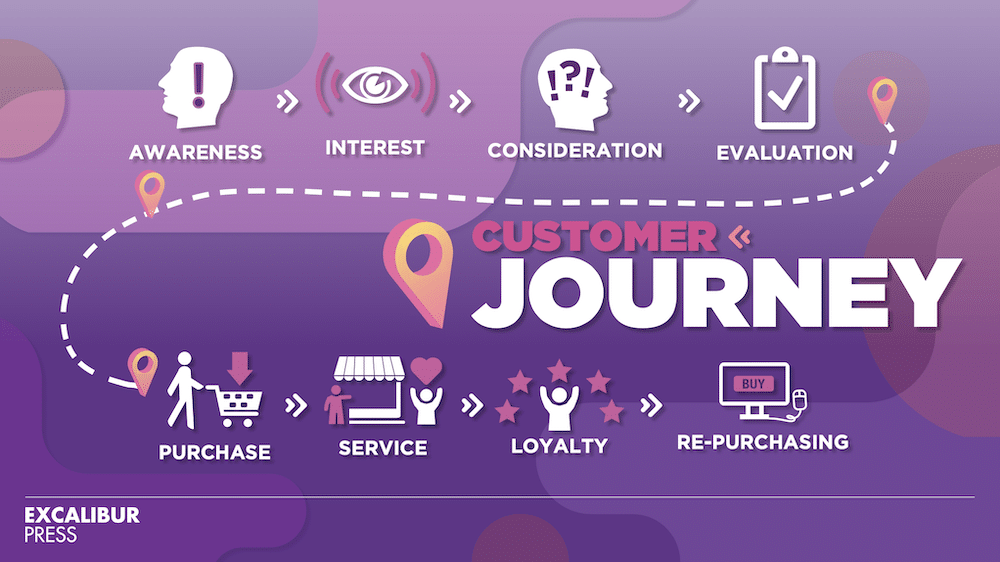
Design: Oranga Creative, Belfast
In order to create an effective marketing or content strategy it’s essential to really dig into each of these steps in order to ensure you are communicating effectively with your prospects, leads and customers.
Just because someone has become a customer doesn’t mean you should stop worrying about them – they’re deep in your customer journey and you will need to communicate differently with them than you do with those who are just finding out about you.
1. Awareness

In the awareness stage of the customer journey your prospective buyer is only learning about your existence. They possibly know very little about you and are therefore on the lookout for information that gives them more of an understanding about who you are, what you stand for and what you do.
More often than not in this first stage buyers rarely know exactly what they want or need. In some cases they might not even know what possible solutions are out there – they may not have even identified the problems they have.
Now is the time to plant those seeds and nurture them to grow. Maybe they have come across your product, service or brand in a very basic way, they may have gone looking for specific information and stumbled across something that mentions your company.
Are you confident that your product, service or brand not only helps that prospect highlight what they need but also represents the solution they require?
One thing you need to be aware of is that your prospect is cold at this point, they are often unsure and may not have even developed an active interest in buying at this stage. Think of it as an idea ruminating around their brain.
A good example of the customer mindset at this point is: The customer is in the market for a new vehicle and sees this particular one in a television advert. They take a mental note, but don’t do much else at this stage.
63% of consumers who ask for information about your business or products won’t make a purchase for at least 3 months. Source: marketingdonut.co.uk
2. Interest
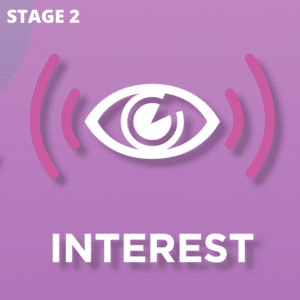
At some point your customer will exit the awareness stage and move into an active interest stage. At this point, they want to know more, they want to learn more about what you or your product, service or brand can offer.
At this point the driving force could be their own desire or external circumstances which now prompt them to see the benefits and/or value of potentially engaging with you – or another similar company.
Usually something will have piqued their interest, maybe the car they saw on TV actually drove past them, and seeing it up close really engaged their emotional response of wanting the car. Maybe their current car has started to make funny noises and they know it’s on the way out.
Clever marketing will help move a prospect from the awareness stage right through into interest. Your prospect is no longer just aware of the car but they’ve begun to imagine themselves driving it, they are now thinking about what life will be like with this car in it.
Companies that excel at lead nurturing generate 50% more sales-ready leads at 33% lower cost. Source: marketingprofs.com
3. Consideration
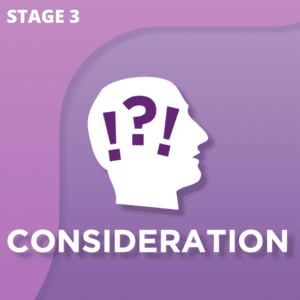
At this point your potential customer is actively going out of their way to learn more about the product or service.
It is generally felt that once a customer moves into the “consideration” phase they are not only genuinely considering the purchase but they are a “warm lead” for you to nurture.
If we stick with our car example, at this point the customer is no longer just daydreaming about the car but are now working out their finances to see if they can afford it.
That’s not the only thing your prospective customer is doing at this stage, they’re also weighing up their options and they’re looking at your competitors.
They’re now looking at the features and the benefits of your product or service and they’re deciding whether or not they want to stick with you or move to a competitor.
Getting the right content in front of your prospective customer at this point in your sales funnel is absolutely vital. If your prospective customer can’t find the information they want or need then a competitor could swoop in and take them from under you just because they were communicating a better message.
90% of customers are influenced by positive reviews when buying a product. Source: Zendesk
4. Evaluation
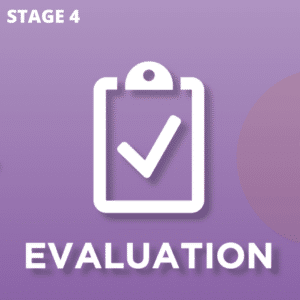
Now we’re getting serious. If your prospective customer gets to this stage in their customer journey then you’re definitely in the running for a sale.
In essence the “evaluation” stage is an extension of the “consideration” phase. However, by this point usually deep down the customer has made the bulk of their decision – they usually have a gut feeling or an inkling of which way they’re going to go with regards to their purchase.
By this point your customer has convinced themselves that they will make a purchase.
By now they want to make the purchase and in many cases need to.
Whilst the majority of the decision making is complete this is not a lost cause – there’s still the opportunity to change the customer’s mind if they’re not swaying towards you.
At this point you want to ensure you are serving content to the customer or have content available to the customer that is essentially a final summarisations of the options available and why they should buy.
In the car example, this is the point when the customer has visited the dealership and test drove the car. As well as a few others to be sure it’s right for them. Now they have gone away for one final discussion with a loved one to come to a conclusive decision.
When B2B buyers are considering a purchase, the majority of that time is spent researching independently online. Source: Gartner
5. Purchase
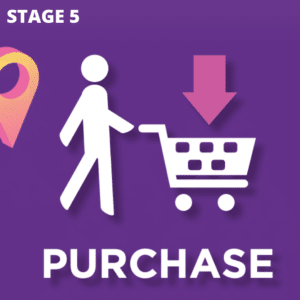
The purchase is the culmination of each of the prior stages. The customer has become aware, interested, considered their options, evaluated the situation and has now decided to make their decision to buy.
The product or service purchased has represented the best choice for them and they have parted with their money. However, the sale being made doesn’t conclude the transaction or the journey.
88% of consumers are influenced by online customer service reviews when making a buying decision. Source: Zendesk
6. Service
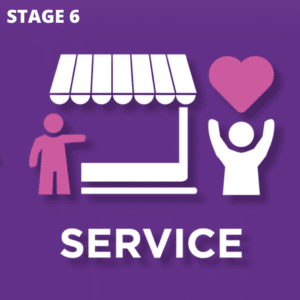
The service stage of the customer journey can represent several things. It can be crucial to the purchase itself before and after. It represents the experience the customer had during the sales process and how the relationship between buyer and seller evolves after this.
The one thing you want to avoid, especially if you have a cooling off period or a “money back guarantee” is the customer getting “buyer’s remorse” at this point. Regretting their transaction is the last thing you want them to be feeling in the time immediately after their purchase.
This is where your customer service and follow up is absolutely vital, it is a critical factor in influencing what your customer will do next and whether or not this is the end of their customer journey with you or whether they progress to other stages.
If the customer feels ignored, disrespected, misled or insulted at any point before or after the transaction this could lead to them changing their mind at some point.
In our car example the word “service” could mean literally. The customer may need to return to the dealership periodically for check-ups, parts and maintenance for their vehicle. Making them feel valued at this stage is just as important as ever, as a customer who feels abandoned after a sale is likely to not return or recommend the seller.
66% of customers will pay more for a great experience (82% for businesses) Source: Salesforce
7. Loyalty

If you get the customer journey right up to this point you can create a very powerful customer. Moving your customer through the journey and into the loyalty stage is where most marketers hope they will land.
One of the reasons “service” is so important is because it leads to customer loyalty. Humans are creatures of habit and if we like a product or service, we will continue to purchase it. This creates a reliable stream of income for the seller and next time the sales process will be much easier. The customer may not spend as long considering and evaluating before a purchase, and they are already aware and interested.
In the “loyalty” stage you’re creating brand ambassadors or brand advocates. People who will go on to tell others about your brand and repeat their experience with you to anyone who might be interested. There’s nothing like word of mouth to guarantee a sale.
These customers will actively praise your product or service and will have a positive view and outlook on your brand. Their recommendations will install feelings of confidence in other buyers whose own path through the journey will be smoother because of this.
96% of consumers say customer service is an important factor in their choice of loyalty to a brand. Source: Microsoft
8. Re-Purchase
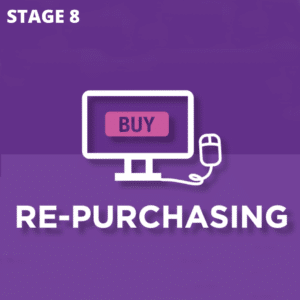
The 8 Stages of The Customer Journey are a cycle that re-occurs every time the customer needs a product or a service.
If it’s done correctly and you’ve effectively moved people seamlessly through your entire funnel then the initial stages can be shortened or even skipped when a re-purchase is on the cards.
If a customer buys a car and they find that car to be reliable, enjoyable to drive and good value for money then they are likely to use that brand again. If the customer has been treated well before, during and after the purchase this will only encourage them further.
This is the point at which some companies become complacent. Don’t just assume because someone has bought from you before they’re not expecting the same customer journey, experience and service. In fact, in some cases, they’ve such a high opinion of you and your brand you have a lot to live up to.
Don’t neglect these customers by not nurturing them through your content and marketing strategy, they are just as important (if not more) than each and every new customer you encounter.
Customers who had a very good experience are 3.5x more likely to repurchase and 5x more likely to recommend the company to friends and relatives than if they had a very poor experience. Source: customerthermometer.com
Other resources used:
customerthermometer.com | protocol80.com | all others hyperlinked above
Do you need help creating content for your business or reaching out to the press and media?
At Excalibur Press we have a team of over 12 publicists, content creators, copywriters, journalists and bloggers in a variety of specialisms writing blogs, website content, video, photography and more for clients on a daily basis.
If you would like to speak to a content creator or publicist or would like more information about our rates and process just call 07305354209 or email [email protected].
Find out more about Excalibur Press at excaliburpress.co.

